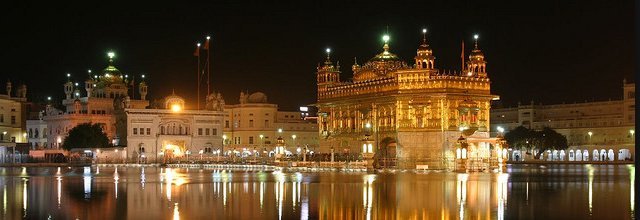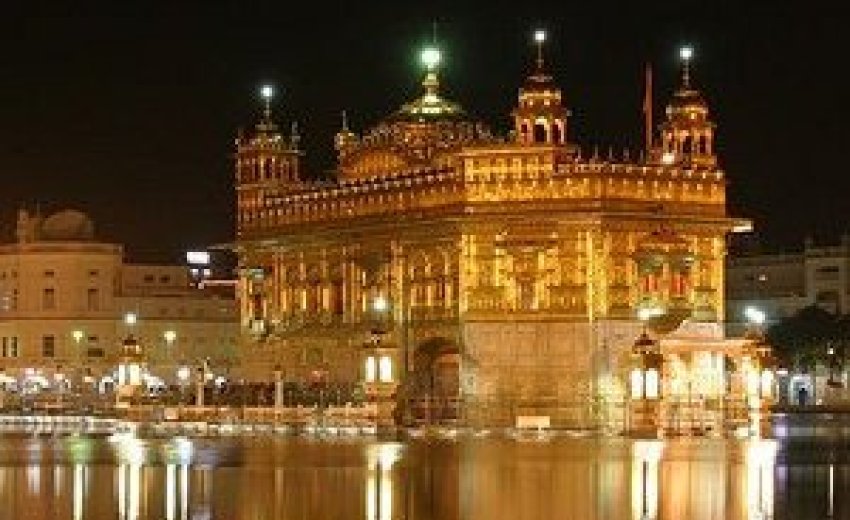
Andy Warhol once said that everyone will be famous for 15 minutes; he'd obviously been to the Golden Temple in Amritsar.
During our visit to the sacred Sikh site in the Indian region of Punjab, we wondered whether we had been mistaken for someone else – someone quite famous.
We were constantly surrounded by curious Sikhs who wanted to touch, photograph or just stare at us.
On several occasions we even had babies thrust into our arms or were asked to stand among family for a group photo. Some friendly locals told us it was our light skin and hair that piqued their interest. Whatever, it was a surreal experience and we certainly felt we'd had our 15 minutes of fame.
The Golden Temple or Harmandir Sahib is the most revered religious center in Sikhism and a place all Sikhs aim to visit at least once in their lives. The day we visit there are thousands of them there ... many queuing to get into the temple itself, others bathing in the holy waters that surround the temple and some just sitting in the shade and soaking up the spirituality.
This place hasn't always been so peaceful – in 1984 the Indian Army, under orders from Prime Minister Indira Gandhi, stormed the temple to arrest a Sikh on suspicion of terrorist activity. The fighting that ensued resulted in the deaths of more than 500.
A few months later Ms Gandhi was assassinated by two of her Sikh bodyguards in what was considered a revenge attack. The bullet holes from the fighting can still be seen today and plaques commemorating victims line the walls.
But violence is far from the minds of those visiting today – the calmness and tranquillity is palpable as thousands move slowly past the astonishing temple, the haunting chanting of Sikhs accompanying them.
Amritsar lies just 30 kilometres from the Pakistan border in north west India. A typically grubby, noisy, crowded and bustling Indian city, its main attraction is the Golden Temple and we head there on arrival, which just happens to be late evening. The sight of the golden edifice glowing in the moonlight leaves an indelible impression.
Built in the early 1600s, the gold was added to the roof and dome in 1802 – some say up to 750kg was used. It contrasts beautifully with the white marble, much of which is decorated with animal and flower motifs in a similar style to that used at the famed Taj Mahal.
It's easy to see why the temple is such a special place. It is astonishingly beautiful and atmospheric and we are overawed as we shuffle slowly along the cool marble floors.
We find ourselves moving with the crowds away from the main walkway and before long we're in a queue. Unsure just where we are going, we go with the flow.
Next thing a tin tray, bowl and spoon is thrust into our hands and we file into a massive dining room where thousands of Sikhs are sitting cross legged on the floor in long lines. We follow suit and within minutes men with huge pails slop dahl (lentils), potato curry and rice pudding into our tray and hand out chapatti (unleavened bread).
We'd read about this feeding of the masses and have managed to stumble into it quite by accident. It's over fairly quickly and the doors are opened to reveal another huge crowd waiting expectantly with their trays.
This is an operation run with military precision and it has to be as up to 20,000 people a day are fed in this vast hall. We file out and hand our dishes to a highly efficient team that flings the trays into a massive bucket while water is sloshed over them. Not the most hygienic but the food doesn't cause us any problems.
We wander back out to the lake where turbaned Sikhs strip to their underwear and dip in the sacred water, women bathe their children and others splash their faces. As we reluctantly depart through the marble archway we feel quite privileged to have spent time in such a special place of worship and had a glimpse into the Sikh religion.
That night we taxi to the Pakistan border for a bizarre ritual that takes place every evening as the border is closed, the flag ceremoniously lowered and the massive gates slammed shut. Soldiers on both sides wear silly hats and try to outdo each other in a series of Monty Phythonesque marches. There is much high kicking of legs, swinging of arms, beating of chests and shouts of encouragement from other soldiers. This is all accompanied by Indian songs, chants and blowing of horns as the 30,000 strong crowd goes wild.
The most hilarious moment comes when six of the most athletic Indian soldiers kick their left foot as high as it will go – way past shoulder height – trying to kick higher than the last chap. Seemingly pleased with this high straight leg movement they smirk and march back to line to the roars of the crowd.
It can only happen in India!
- The Marlborough Express

